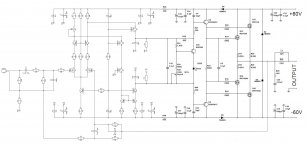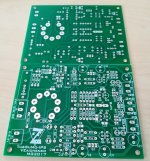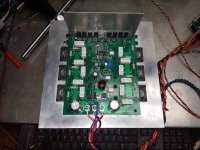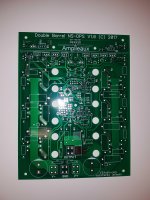Sorry - one more pretty cool IPS module
I just came across M-02 / MX-100 front-end and realized it's designed based on the same principles I like to use these days ("Bravo Luxman engineers!"). Besides the jFET input pair (transconductance stage), all the rest of the circuit is controlled purely by current, resulting in rather high slew rate (around 100V/uS with OPS in place), low distortion with excellent profile, low phase shift at 20KHz and excellent stability margins with very light compensation. As a cool bonus - perfect clipping.
My version of the topology uses mostly TO-126 devices - most of them dissipate 150...170mW, except LTP's tail (Q3) - it runs at 450mW.
Besides BF862, 2SK170 jFETs can be used in the input pair (layout needs to be updated in this case).
Luxfront can be used with any OPS, published in this thread.
It's also compatible with Slewmaster OPS boards.
Diy-friendly layout for etching is attached (PDF).
Do you mean a something like this combo?
Interesting NFB arrangement Luxman used, as it allowed using a film cap.
Attachments
Hi Valery,
is it possible to add a BJT output stage to your Lichtstark IPS design? I'm about to rework two Klein & Hummel power amplifier modules from an ES-707 integrated amp thaw show some major design flaws (see schematics from elektrotanya). Instead of converting them from quasi to true complementary outputs, I'm now opting for the following: As their physical construction (enclosure parts, heat sinks...) resticts me to two pairs of TO-3 units each, I'm considering your Lichtstark, followed by two ONS »Perforated Emitter« MJ15025/26 pairs - the fastest TO-3 devices I know in this power specs range. As the completed build might be used in rather rough environments, an IV limiter is a must. On the other hand the PSU will be a chain of four very cheap 24V/2.5A SMPS per channel to get ±48 Vdc rails. I've yet tested them, they can be overloaded to 3A at least for half an hour. But somewhere surely there's a current limitation. Do I need a current limiter within the amp design despite of that?
Best regards!
is it possible to add a BJT output stage to your Lichtstark IPS design? I'm about to rework two Klein & Hummel power amplifier modules from an ES-707 integrated amp thaw show some major design flaws (see schematics from elektrotanya). Instead of converting them from quasi to true complementary outputs, I'm now opting for the following: As their physical construction (enclosure parts, heat sinks...) resticts me to two pairs of TO-3 units each, I'm considering your Lichtstark, followed by two ONS »Perforated Emitter« MJ15025/26 pairs - the fastest TO-3 devices I know in this power specs range. As the completed build might be used in rather rough environments, an IV limiter is a must. On the other hand the PSU will be a chain of four very cheap 24V/2.5A SMPS per channel to get ±48 Vdc rails. I've yet tested them, they can be overloaded to 3A at least for half an hour. But somewhere surely there's a current limitation. Do I need a current limiter within the amp design despite of that?
Best regards!
Last edited:
Hi Valery,
is it possible to add a BJT output stage to your Lichtstark IPS design? I'm about to rework two Klein & Hummel power amplifier modules from an ES-707 integrated amp thaw show some major design flaws (see schematics from elektrotanya). Instead of converting them from quasi to true complementary outputs, I'm now opting for the following: As their physical construction (enclosure parts, heat sinks...) resticts me to two pairs of TO-3 units each, I'm considering your Lichtstark, followed by two ONS »Perforated Emitter« MJ15025/26 pairs - the fastest TO-3 devices I know in this power specs range. As the completed build might be used in rather rough environments, an IV limiter is a must. On the other hand the PSU will be a chain of four very cheap 24V/2.5A SMPS per channel to get ±48 Vdc rails. I've yet tested them, they can be overloaded to 3A at least for half an hour. But somewhere surely there's a current limitation. Do I need a current limiter within the amp design despite of that?
Best regards!
How much space do you have to work with? I have a version running with two pairs of hexfet outputs. They may be possible to convert to BJT or just run the fets. They are more robust devices and the amp sounds great as is. They are designed to run on +/-48V rails too.
We have a protection system designed to plug into these amps that will shut the amp down if current flow in the output stage exceeds SOA of the devices. Standard IV limiting often makes an amp sound bad at higher volume.
Your HexFETs aren't TO-3 devices, are they? As said, there's no other option than for TO-3's. I have to design my own PCBs, as their size has to match the originals, i.e. 190 x 100 mm. No further restrictions, though.
Best regards!
I misread the TO-3 part. I was thinking TO-3P.
I would recommend this OPS:
1 or 2 pairs of BJT output devices
Marc has designed a very good compact layout for it.
1 or 2 pairs of BJT output devices
Marc has designed a very good compact layout for it.
Hi Valery,
ss said before, I'm restricted to TO-3 power devices. Can I use ONS MJ15025/26 instead of these Sanken transistors?
Best regards!
OK, they will work, but be careful with HF signals - I would tune the input RC filter to some 50KHz roll-off and would not try to pass anything above that frequency through the amplifier - there's danger of rail-to-rail current shoot-through - those transistors close much slower that RET devices, like those Sanken ones.
Would the ONS MJ21195/96 pair be a better choice? Seems that I've mixed them up with MJ15095/96. MJ21195/96 feature Perforated Emitter Technology. Does this correspond to Ring Emitter?
Best regards!
Those are very slow too. I have a couple boxes of those laying around that I've been wanting to find a project for. Looks like they should go into a power supply instead of an amp.
76x100 family is growing....
TubSuMo re-intrepretation post : http://www.diyaudio.com/forums/solid-state/277087-revisiting-some-old-ideas-1970s-ips-ops-212.html#post5099510
TubSuMo re-intrepretation post : http://www.diyaudio.com/forums/solid-state/277087-revisiting-some-old-ideas-1970s-ips-ops-212.html#post5099510
Attachments
- Home
- Amplifiers
- Solid State
- Revisiting some "old" ideas from 1970's - IPS, OPS



